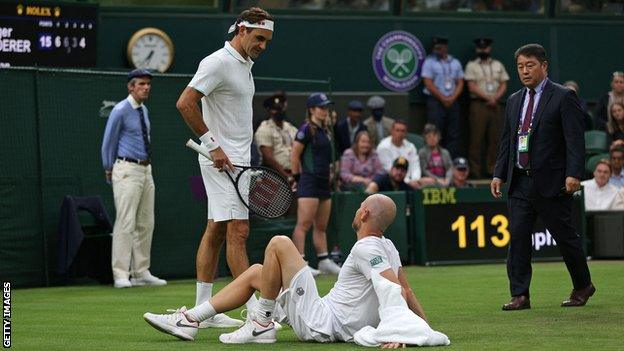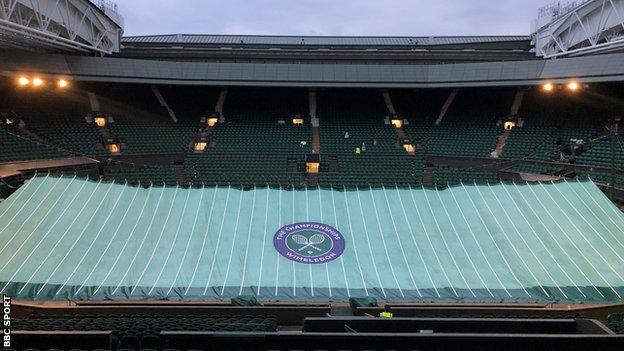Wimbledon 2021: Roger Federer says grass is 'slippery under roof' after Mannarino & Williams injuries
- Published
Wimbledon 2021: Tearful Serena Williams forced to retire
Wimbledon 2021 on the BBC |
|---|
Venue: All England Club Dates: 28 June-11 July |
Coverage: Live across BBC TV, radio and online with extensive coverage on BBC iPlayer, Red Button, Connected TVs and mobile app. Full details here |
What is making Wimbledon's Centre Court so slippery?
After a slip on the famous grass court forced Serena Williams to retire injured within an hour of Roger Federer advancing when his opponent Adrian Mannarino also pulled out following a fall, the spotlight is on the conditions.
World number one Novak Djokovic said he did not recall "falling this many times on court" after several tumbles in his opener against Britain's Jack Draper on Monday, while Andy Murray says it is "extremely slippy out there".
Federer suggested it was "more slippery under the roof", which was on for much of Tuesday's play and some of Monday's while rain fell at SW19.
"You do have to move very, very carefully out there," Federer said.
"I do think it feels a tad more slippery maybe under the roof. I don't know if it's just a gut feeling."
Federer, who was told of Williams' injury during his news conference, said the court felt drier during the day.
"I feel for a lot of players - it's super key to get through those first two rounds because the grass is more slippery, it is more soft.
"As the tournament progresses, usually it gets harder and easier to move on.
"This is obviously terrible that it's back-to-back matches and it hits Serena as well. I can't believe it."
Following the retirements for Mannarino and Williams, the All England Club said: "The weather conditions on the opening two days have been the wettest we have experienced in almost a decade, which has required the roof to be closed on Centre Court and Court One for long periods.
"This is at a time when the grass plant is at its most lush and green, which does result in additional moisture on what is a natural surface.
"With each match that is played, the courts will continue to firm up."
Allow X content?
This article contains content provided by X. We ask for your permission before anything is loaded, as they may be using cookies and other technologies. You may want to read X’s cookie policy, external and privacy policy, external before accepting. To view this content choose ‘accept and continue’.
Why are grass courts so slippery?
Play has been disrupted by rain on the first two days of the championships and only Centre Court and Court One have roofs.
It is not unusual for grass courts to be slippery, but when they are under cover for longer, conditions become more humid, which in turn makes the grass more damp.
Pat Cash, who won Wimbledon in 1987, described players as looking like "Bambi on ice" as they tried to navigate the slippery areas.
"Grass courts are slippy and that is the challenge of playing on them," he said on 'Today at Wimbledon'.
"They have three different phases - very slippery, slippery on the outside and then towards the end of the tournament we get dust. It makes it really tricky."
What have the players said?

Adrian Mannarino (right) described his knee injury as a "classic grass-court injury"
Mannarino, who has never beaten Federer, said he heard "a big crack" in his knee as he fell on the baseline.
The 33-year-old played on through the fourth set but could only manage one point of the decider before retiring.
"The court definitely felt slippery to me," he said.
"I wasn't able to change directions, wasn't comfortable with that. Definitely not the best sensations since the beginning of the match."
Williams, who had her right thigh heavily strapped, slipped on the baseline at the same end that Mannarino injured himself.
She went off court to receive treatment but was reduced to tears as she attempted to serve through the pain, and was ultimately helped off court.
Her opponent Sasnovich said the conditions made it difficult for her to run down Williams' shots.
"It was very slippery - I fell as well. When she did an angle, I couldn't run, because it was so slippery," she said.
What is it like under the Centre Court roof?
Jonathan Jurejko, BBC Sport at Wimbledon
Grass surfaces are always tricky to play on and adapting to the 'virgin' surface - as Djokovic called it the other day - is part of the challenge at Wimbledon.
From close up on Centre Court, the surface looks very lush.
Combined with the precipitation in the air, and the greenhouse effect created by the roof being shut throughout most of the opening two days, it appears to have contributed to a more treacherous surface than usual.
Within an hour of Williams hobbling off in tears, the Centre Court sprinklers were put on and water sprayed over the grass - including behind the two baselines.
The surface was then covered by a green protective tent before the roof was opened for the night.
It goes without saying Wimbledon's experienced ground staff know what they are doing and they regularly ask for feedback from the players.
Head groundsman Neil Stubley once said worrying about the surfaces gave him sleepless nights.

Centre Court under cover for Tuesday night

Starstruck: The one-night stand that has blockbuster consequences
Advice from former Love Islanders: What do they wish they had known before entering the villa?
